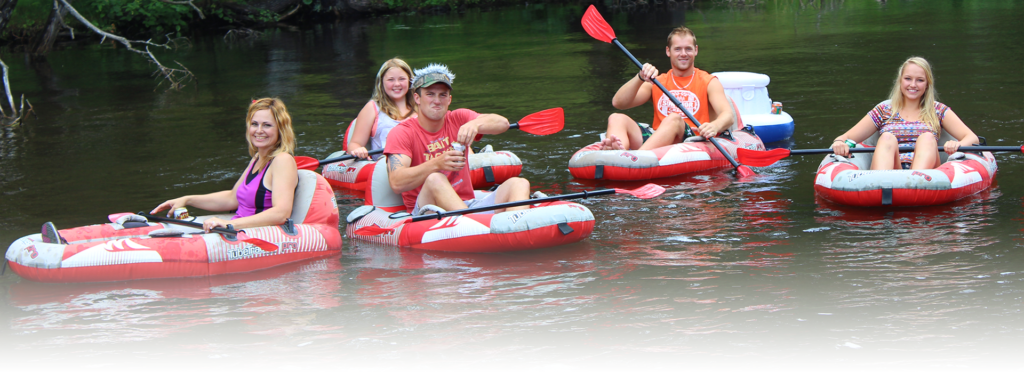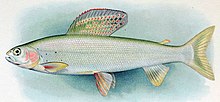Shel-Haven Canoe and Kayak Livery is located on highway M-72 between Grayling Michigan and Kalkaska Michigan. Here’s some fun information about each town.
Grayling Michigan
Grayling (/ˈɡreɪlɪŋ/ GRAY-ling) is a city and the county seat of Crawford County in the U.S. state of Michigan. It is the only incorporated community in Crawford County.[4] The population was 1,884 at the 2010 census.[5] The city is surrounded by Grayling Charter Township, but the two are administered autonomously.
The city is located in the middle of the Northern Michigan region at the junctions of Interstate 75, U.S. Route 127, M-72, and M-93. Grayling is well known for hosting the Au Sable River Canoe Marathon in July of every year since 1947. The city is named after the Grayling species of fish once abundant in the Au Sable River, although the species has long since been extinct in the area.[6] There have been many attempts to bring Grayling back to the area but none have been successful.
History
Michael Shoat Hartwick was Grayling’s first settler. On the west side of the railroad tracks, he built a log hotel. The railroad platted out 40 acres (where Grayling now stands), naming it “Crawford”. Fish swimming in the river were identified as grayling, and it is said that the residents preferred the name “Grayling” to the name “Crawford,” and renamed the area after the fish.[7]
Grayling’s access to two major rivers (Au Sable River and Manistee River), and the presence of the vast forest around it, made it important in the lumber era. Logs were floated down the rivers to the lakes.[8]
Grayling had other names through the years. It was called “AuSable”, “Forest”, “Crawford Station”, and during the lumbering era “Milltown”.[9]
The “Grayling” Fish
The Arctic grayling that had inhabited much of Northern Michigan[10] was eventually wiped out. The logging practice of using river beds to move logs in the springtime destroyed the breeding grounds for these fish.[11] Before they could recover, non-native sport fish such as brook trout were introduced in the 1890s[12] and competed with the grayling for food.
The Grayling Fish Hatchery was founded in 1914 by timber baron Rasmus Hanson (1846–1927).[13] He hoped to restore the grayling to the Au Sable River system; ironically, its disappearance was caused, at least in part, by the massive habitat destruction caused by logging, which was the source of Mr. Hanson’s and other lumber barons‘ immense wealth. Other famous contributors to the initial costs of the hatchery included Henry Ford, Edsel Ford, and Thomas Edison.[13] The grayling became extinct in Michigan. Nevertheless, the hatchery continued to play an important role in natural resource conservation. In 1926, it was sold to the state of Michigan. It continued to be operated as a fish hatchery and tourist attraction until the mid-1960s. In 1995, Michigan sold the property to Crawford County. It is being operated by a privately owned fish farm, although continues to be open to the public during the summer.[14]
An important person in the history of Grayling is Rasmus Hanson. Hanson was born in 1846 in Denmark and immigrated to the United States some time later. At age 16 he began working in the lumber field. Two years later, E. N. Salling, Nelson Michelson, and he organized the first Salling-Hanson Company. After nearly 50 years of service, the Salling Hanson Company had shut down its operation in January 1927. He was a successful entrepreneur and created many businesses in Northern Michigan. Along with being one of three lumber barons of Northern Michigan, Hanson owned the Michigan Sugar Company and the Bay City Sugar Company. In 1916, he donated 13,826 acres of cut-over land in Crawford County to the state of Michigan for use as a forest game preserve and military reservation. This land became the first state-owned game preserve. The area south of Lake Margrethe (named in honor of Hanson’s wife, Margrethe) continues to be used as a National Guard base that serves Michigan, Ohio, and Indiana guards.[15] Since 1947, Grayling has been the starting point of the Au Sable River Canoe Marathon, which is held every year on the last weekend of July.[16] This is the longest nonstop canoe race in North America.
Kalkaska Michigan
Kalkaska (/kælˈkæskə/ kal-KASS-kə) is a village in the U.S. state of Michigan. Kalkaska is the county seat and only incorporated community of Kalkaska County, and is considered part of Northern Michigan. The population was 2,132 at the 2020 census, an increase from 2,020 at the 2010 census.
Kalkaska is part of the Traverse City micropolitan area, and is often considered a bedroom community of nearby Traverse City. The town is also renowned for hosting the National Trout Festival, with the first festivities being held in 1935.
The land on which Kalkaska sits has long been territory under the Council of Three Fires; the Ojibwe, Odawa, and Potawatomi.
In 1872, Albert A. Abbott arrived on the land set to become the village from his hometown of Decatur. The following year, on May 12, 1873, Abbott platted his land, and became its first postmaster.[7] In 1874, Kalkaska became a station on a new Pennsylvania Railroad line from Walton to Petoskey.[8] Today, this line is part of the Great Lakes Central Railroad.[9]
On July 5, 1908, a fire began in the middle of the business block and burned most of the stores. Local photographer E. L. Beebe made a number of photographs of the fire, and the resulting postcards were widely sold, and can still be found today.[10] Two years later, in 1910 another fire started in downtown Kalkaska. Again, in 1925 downtown Kalkaska was devastated by the largest fire since the Fire of 1908.[11]
In 1916, the noted author Ernest Hemingway visited and fished in Kalkaska, and later immortalized the town in his story “The Battler”.[12] A historical marker has been placed at the nearby Rugg Pond, on the Rapid River, where Hemingway reportedly fished one night from the power house.[13]
On July 10, 1951, the Kalkaska State Bank was robbed by an armed man, who fled and later attempted to escape on foot through a nearby swampy area. After three days of what was termed the largest manhunt in Northern Michigan history, involving the FBI and local and state authorities, the gunman was captured south of the town. Named Raymond J. Turcotte, he had a long string of prior convictions, including manslaughter. Turcotte confessed to the bank robbery and served 18 years in the Michigan State Prison in Jackson, including a term for escape in 1961.
Discovery of natural gas and oil in the area during the 1970s lead to significant growth for the village; however, the growth has since shifted toward tourism.[14]
In 1993, the Kalkaska schools made national headlines when a financial crisis resulted in a two-month-long closure. Subsequent funding reform improved the outlook for Kalkaska and similar small rural districts in Michigan.[15]
In 2014 Walmart announced plans to open a store in Kalkaska. Previously the closest store was in Traverse City, 21 miles away. There was a debate in Kalkaska on whether the community’s small town character can be preserved.[16] The store was never built.
The Record Eagle reported in 2019 that Kalkaska was poised for substantial growth due to housing shortages in the Traverse City area.[17]
Travel and Recreation
Tourists are attracted to the area to visit the surrounding lakes (including Torch Lake) and rivers such as the Jordan River, Rapid River & Manistee River. Kalkaska offers two major festivals, the National Trout Festival held at the end of April to honor the opening of trout season, and the WinterFest which is held in January. Fall color tours are also popular with visitors.
The first weekend of November brings with it the Iceman Cometh biking challenge. Kalkaska hosts the starting line for a 27.2 mile off-road biking race that runs from the heart of the village to Traverse City along the VASA Trail. The turnout for the race very easily doubles the population within the village, numbering in the several thousands. For mountain biking enthusiasts, this is a famous race, and completing the race is an achievement in itself.
The village has several parks, including the newly expanded KART trail which is planned to be connected with the TART Trail.


